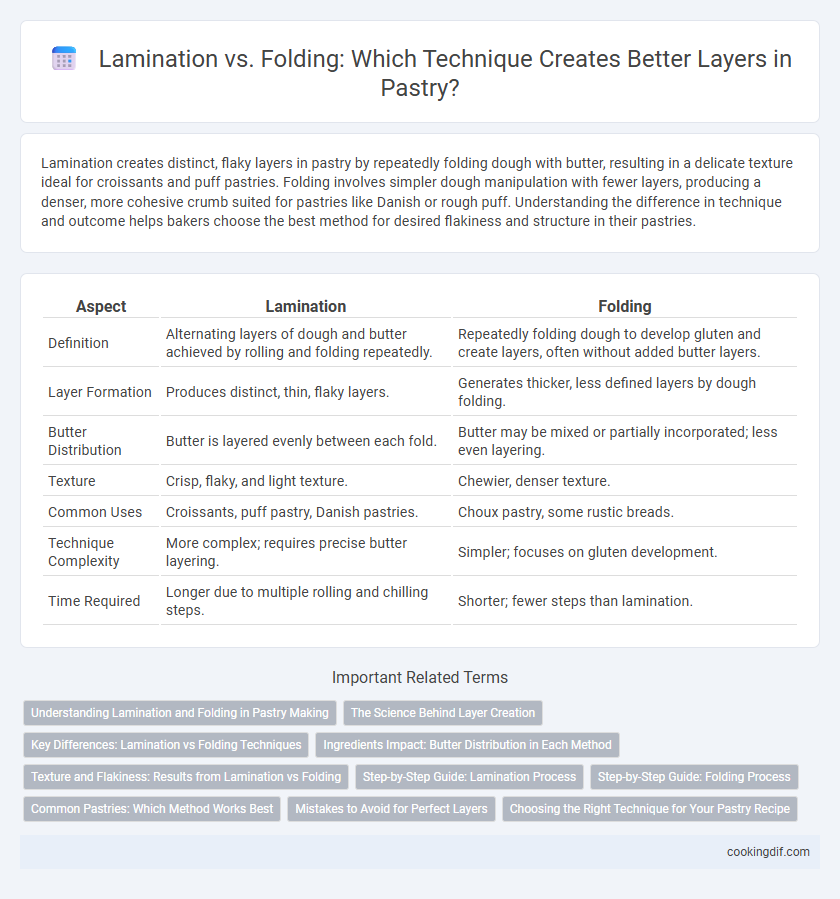Lamination creates distinct, flaky layers in pastry by repeatedly folding dough with butter, resulting in a delicate texture ideal for croissants and puff pastries. Folding involves simpler dough manipulation with fewer layers, producing a denser, more cohesive crumb suited for pastries like Danish or rough puff. Understanding the difference in technique and outcome helps bakers choose the best method for desired flakiness and structure in their pastries.
Table of Comparison
| Aspect | Lamination | Folding |
|---|---|---|
| Definition | Alternating layers of dough and butter achieved by rolling and folding repeatedly. | Repeatedly folding dough to develop gluten and create layers, often without added butter layers. |
| Layer Formation | Produces distinct, thin, flaky layers. | Generates thicker, less defined layers by dough folding. |
| Butter Distribution | Butter is layered evenly between each fold. | Butter may be mixed or partially incorporated; less even layering. |
| Texture | Crisp, flaky, and light texture. | Chewier, denser texture. |
| Common Uses | Croissants, puff pastry, Danish pastries. | Choux pastry, some rustic breads. |
| Technique Complexity | More complex; requires precise butter layering. | Simpler; focuses on gluten development. |
| Time Required | Longer due to multiple rolling and chilling steps. | Shorter; fewer steps than lamination. |
Understanding Lamination and Folding in Pastry Making
Lamination in pastry making involves repeatedly folding dough and butter to create multiple thin alternating layers, resulting in a flaky texture in products like croissants and puff pastry. Folding is a specific technique within lamination where the dough is turned and folded to evenly distribute butter and develop distinct layers. Mastery of lamination and precise folding techniques is crucial for achieving optimal flakiness and rise in laminated pastries.
The Science Behind Layer Creation
Lamination in pastry involves alternating layers of dough and butter through repeated rolling and folding, resulting in dozens of thin, distinct layers that puff up during baking due to steam expansion. Folding alone, without extensive lamination, creates fewer and thicker layers, yielding a denser texture. The science behind laminated dough relies on the precise distribution of fat to separate dough layers, trapping steam and promoting maximum rise and flakiness.
Key Differences: Lamination vs Folding Techniques
Lamination in pastry involves alternating layers of dough and fat repeatedly rolled and folded to create thin, flaky layers crucial for croissants and puff pastry. Folding, often part of lamination, refers to the method of folding the dough over itself to build structure and incorporate air, but it does not always involve fat layers. Key differences lie in lamination's focus on fat distribution for crispiness versus folding's role in dough organization and gluten development.
Ingredients Impact: Butter Distribution in Each Method
Lamination creates multiple thin layers by repeatedly folding dough with cold butter, ensuring even butter distribution results in distinct, flaky layers. Folding involves fewer turns and thicker butter layers, producing denser pastry with less separation between layers. The type and temperature of butter critically influence its plasticity and melting point, affecting the final texture and rise in both lamination and folding methods.
Texture and Flakiness: Results from Lamination vs Folding
Lamination creates distinct, thin, and evenly spaced layers by continuously incorporating butter between dough sheets, resulting in an exceptionally flaky and crisp pastry texture. Folding, while also layering dough, produces fewer and thicker layers, leading to a denser texture with less pronounced flakiness. The precision and repetition in lamination significantly enhance the pastry's lightness and structural integrity compared to the simpler folding technique.
Step-by-Step Guide: Lamination Process
Lamination involves encasing butter within dough and repeatedly rolling and folding to create multiple thin layers that produce flaky, airy pastry. The step-by-step lamination process includes chilling the dough, rolling it out evenly, folding it typically in thirds or quarters, then resting and repeating these folds multiple times to develop layers. This precise technique differs from simple folding, emphasizing temperature control and uniform thickness to achieve superior pastry rise and texture.
Step-by-Step Guide: Folding Process
The folding process in pastry lamination involves repeatedly enclosing butter within dough and folding it to create multiple layers, typically performed using a series of turns such as single or double folds. Each fold multiplies the layers exponentially, with a common method being the "letter fold," which ensures even distribution of butter and optimal layering for flaky texture. Precise temperature control and consistent rolling thickness are crucial throughout the folding steps to prevent butter from melting and to achieve the signature layered structure in puff pastry or croissants.
Common Pastries: Which Method Works Best
Lamination creates distinct, flaky layers ideal for croissants and puff pastries by repeatedly folding dough around butter, enhancing rise and texture. Folding techniques, used in Danish and brioche doughs, develop softer, more pliable layers with enriched crumb through gentler incorporation of fat. For delicate, buttery pastries requiring crispness, lamination is preferred, while folding suits enriched doughs needing tender layers.
Mistakes to Avoid for Perfect Layers
Overworking the dough during lamination can cause gluten toughness, leading to dense, uneven pastry layers instead of the desired flaky texture. Avoid insufficient chilling between folds, as warm dough causes butter to melt, preventing proper steam formation and resulting in flat, greasy layers. Ensure precise folding technique to maintain distinct butter and dough layers which create the characteristic lift and separation in laminated pastries.
Choosing the Right Technique for Your Pastry Recipe
Lamination creates multiple thin, even layers through repeated rolling and folding of dough with butter, ideal for croissants and puff pastry requiring crisp, flaky textures. Folding involves fewer turns, providing a denser, tender crumb suited for pastries like Danish or brioche. Selecting lamination or folding depends on the desired flakiness, dough type, and final pastry structure to achieve optimal texture and flavor.
Lamination vs Folding for pastry layers Infographic

 cookingdif.com
cookingdif.com